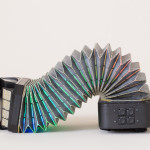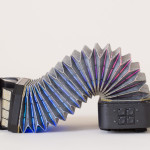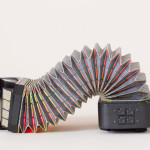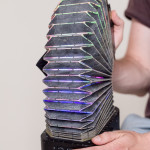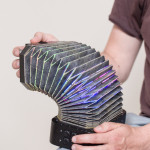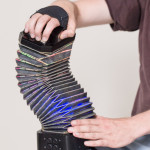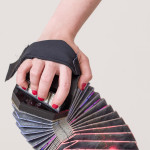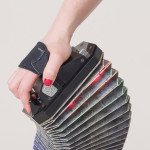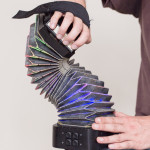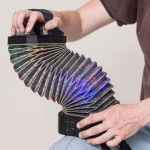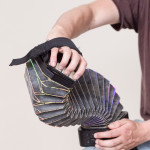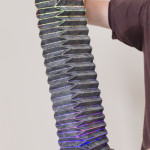-
- Year 2014/2015
- Authors: Dominik Hildebrand Marques Lopes, Amelie Hinrichsen and Till Bovermann
- Affiliation: Berlin University of the Arts, Germany, 3DMIN project
- Official web page: https://www.3dmin.org/pushpull/
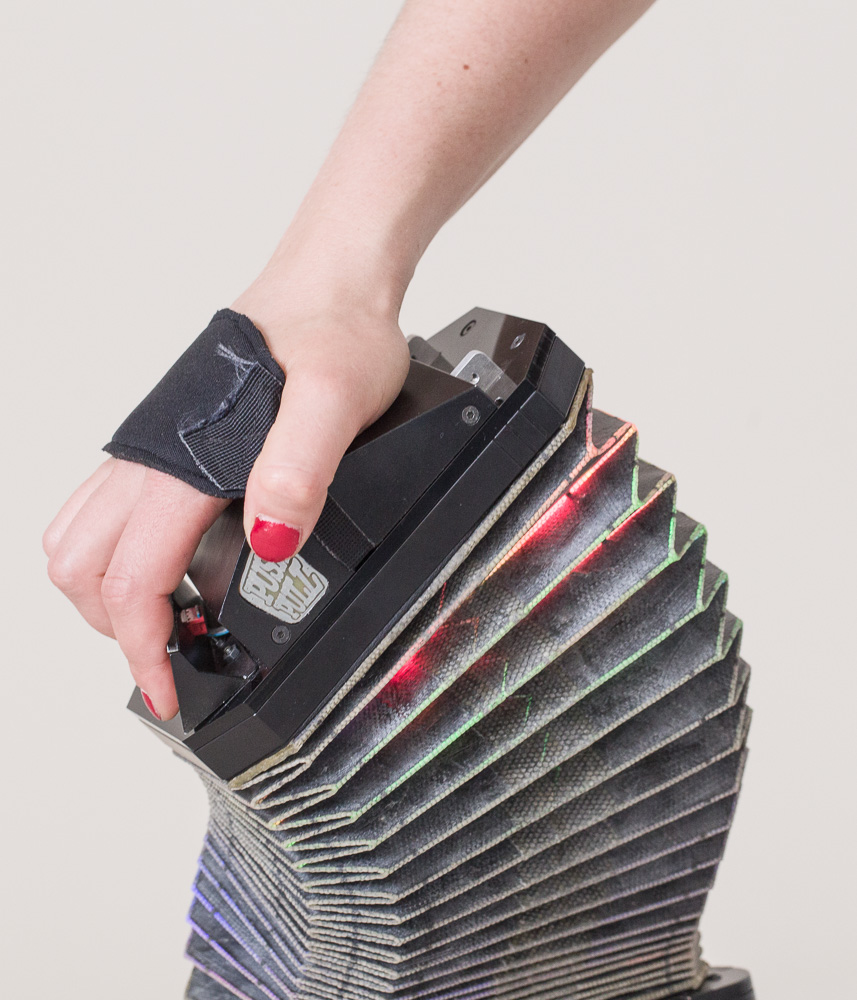
PushPull with hand
- 200 word abstract: PushPull is the first instrument prototype created as part of the 3DMIN project. Central control element is a bellow combining inertial sensor data with mechano-analog sound input and digital synthesis. Referring in it’s exterior appearance to traditional instruments like the accordion as well as to a blacksmith’s bellow we aimed to establish an interface triggering imagination and engagement of both, the musician and the audience, a tangible object enabling a physical relation to the created sound. We think that in the characteristic air movement, the affordances offered by the object itself, the combination of complex algorithmic structures and physical constraints lays a compelling quality of expression. Within a performance with PushPull, it is possible to combine chaotic elements as well as rhythmical patterns, while shifting between audio feedback and harmonic structures. The ensemble performed within Europe and internationally: Atlanta, Georgia (3rd place at Guthman Competition, March 2015), Amsterdam (Modality Meeting, OT301, April 2014), Berlin (Roter Salon, Juli 2014), Athens (ICMC, September 2014) and Lissabon (ICLI, November 2014).
-
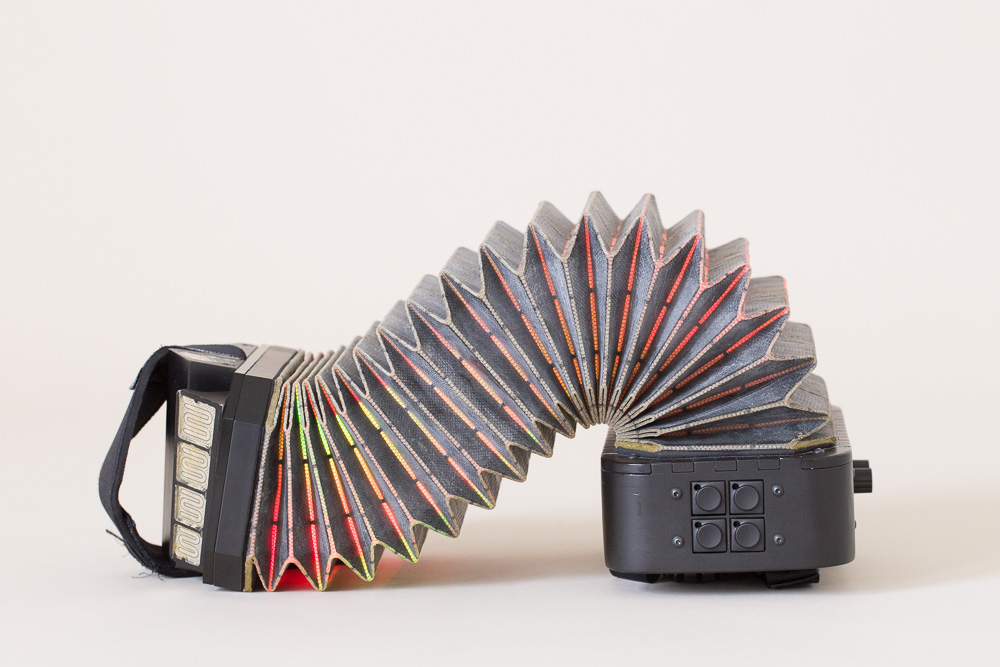
PushPull overview
400 word abstract: Balgerei is a performance with three similar instruments called PushPull. Central control element is a bellow combining inertial sensor data with mechano-analog sound input and digital synthesis. During the performance the trio touches chaotic elements as well as rhythmical patterns, while shifting between audio feedback and harmonic structures.
Moving the hand piece activates the bellow. Hand movements restricted by the limitations of the bellow turn into gestures and create air flow over a microphone. Inertial sensors in the hand piece together with a thumb stick allow for continuous sound shaping, while four buttons complete the setup to trigger changes or change between synthesis engines.
Referring in its exteriour appearance to traditional instruments like the accordion as well as to a blacksmith’s bellow we aimed to establish an interface triggering imagination and engagement of both, the musician and the audience, a tangible object enabling a physical relation to the
created sound and necessitating a set of movement patterns1. We think that in the characteristic air movement and the affordances offered by the object itself lies a compelling quality of expression, which was also observed by the makers of more recent electronical instruments like the accordiatron (M. Gurevich & S. Von Muehlen) or the squeezevox [sic] (P. Cook & C. Leder, both 2000).
PushPull is the first instrument prototype created as part of the 3DMIN project. This new musical interface was originally developed for a concert at the Modality Meeting in Amsterdam (April 2014). First intended to be just a one week lasting internal workshop the set up seemed to be promising enough to develop the prototype further. The ensemble performed within Europe and internationally: Atlanta, Georgia (3rd place at Guthman Competition, March 2015), Amsterdam (Modality Meeting, OT301, April 2014), Berlin (Roter Salon, July 2014), Athens (ICMC, September 2014) and Lissabon (ICLI, November 2014). - Activity:
- 03.2015 – 3rd place at the Guthman Award, GeorgiaTech, Atlanta.
- 11.2014 – Paper presentation at ICLI 2014 (pdf): PushPull. Reflections on Building a Musical Instrument Prototype
- 11.2014 – Performance at ICLI 2014 (Abstract), Lissabon
- 10.2014: Performance at ICMC/SMC in Athens
- 07.2014 – Performance at Roter Salon
- 06.2014: Performance at the Audio Communication Day 2014
- 04.2014: Performance at the modality concert, presented by nescivi and STEIM at OT301
- Bios of Authors:
- Amelie Hinrichsen is a Research Associate in the Einstein research project 3DMIN (Design, Development and Dissemination of New Musical Instruments) at the Berlin University of the Arts. After accomplishing an apprenticeship as a carpenter she completed her studies in Product Design at the Berlin University of the Arts in 2012. With her final project she won the DMY Young Talents Jury Award in 2013. After working as a freelancer for Friedrich von Borries she joined the 3dmin Team in 2013.
Amelies work ranges from film over product- to interface design. It reflects her interest in combining theoretical research with a practical approach, always physicalness and personal experience in focus. Currently she is working on her dissertation dealing with „Attitude and Posture – Performing Life with electronic musical instruments“. - Dominik Hildebrand Marques Lopes has a degree in audio and video engineering from the Institute for Music and Media Düsseldorf. Furthermore he studied Arts and Media at the University of the Arts (UdK) Berlin, focusing on multichannel sound installations, improvised electronic music, building kinetic/cybernetic (sound-)objects, musical recording, and live-coding. He also holds a “Meisterschüler” (distinguished graduate) degree in Arts and Media. Currently he is working as a Research Associate in the Einstein research project 3DMIN (Design, Development and Dissemination of New Musical Instruments) at the Berlin University of the Arts. He is also lecturer at University of the Arts Bremen (Digital Media).
As a computer musician, his main focus is on developing and performing with physical musical interfaces whose constraints and functionality are chosen to exhibit unique behaviour (or life of their own) arguably equally rich as many acoustic instruments. This approach leads to very direct bodily control of computational processes which hopefully can also be experienced as such by the audience. Dominik is a member of “Trio Brachiale”, “Republic111”, and the “Society for Nontrivial Pursuits”. - Since the beginning of 2014, Till Bovermann is a post-doctoral researcher at 3DMIN (Design, Development and Dissemination of New Musical Instruments), an Einstein research project between the Berlin University of the Arts and the Technical University Berlin.
From 2010 to 2013, he worked as a post-doctoral researcher on tangible and auditory interaction at Media Lab Helsinki, School of Art, Design and Architecture, Aalto University, Helsinki, Finland.
He completed his PhD in Computer science in the natural sciences on Tangible Auditory Interfaces at the Ambient Inteligence Group of Bielefeld University, Germany.
Till taught at various international institutions, among others the Institute For Music And Media of the University of Music, Duesseldorf; the Department of Media of Aalto University, Finland, and the Institute for Time-based media, UdK Berlin.
His art works are mostly concerned with the relations of art and science, noise and harmony, nature and artificiality.
Alongside his academic and artistic work, he also develops software in and for SuperCollider.
- Amelie Hinrichsen is a Research Associate in the Einstein research project 3DMIN (Design, Development and Dissemination of New Musical Instruments) at the Berlin University of the Arts. After accomplishing an apprenticeship as a carpenter she completed her studies in Product Design at the Berlin University of the Arts in 2012. With her final project she won the DMY Young Talents Jury Award in 2013. After working as a freelancer for Friedrich von Borries she joined the 3dmin Team in 2013.
- Literature:
- Cook, P. (2001). Principles for designing computer music controllers. In Proceedings of the 2001 conference on New interfaces for musical expression, Singapore, Singapore, 2001 (pp. 1d i. National University of Singapore.
- Gurevich, M. & von Muehlen, S. (2001). The Accordiatron: A MIDI Controller for Interactive Music. In Proceedings of the 2001 Conference on New Interfaces for Musical Expression, pages 24-26. Singapore: National University of Singapore.
- Leman, M. & Godøy, R.I. (2010). Musical Gestures. Sound, Movement, and Meaning. New York: Routledge.
- Nancy, J.-L. & M. Monnier (2005). Allitérations. In Allitérations. Conversations sur la Danse. Paris: Galiléé.
- Cook, P. (2001). Principles for designing computer music controllers. In Proceedings of the 2001 conference on New interfaces for musical expression, Singapore, Singapore, 2001 (pp. 1d i. National University of Singapore.

